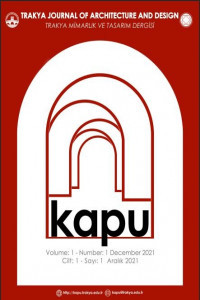Binalarda Pasif Soğutma Yöntemleri ve Geleneksel Mimarideki Uygulamalarının İncelenmesi
Pasif soğutma, Binalarda pasif soğutma, Enerji verimliliği, Geleneksel konut mimari tasarımları, Sürdürülebilirlik.
EXAMINATION OF PASSIVE COOLING METHODS IN BUILDINGS AND THEIR APPLICATIONS IN TRADITIONAL ARCHITECTURE
Passive Cooling, Passive Cooling in the Buildings, Energy Efficiency, Traditional Architectural Design, Sustainability.,
___
- A. Al-Sallal, kh., (2016). ‘Low Energy Low Carbon Architecture Recent Advances & Future Directions’ CRC Press 2016.
- Barthelmes, Verena ,M., Becchio, Cristina, Corgnati, Stefano, P., (2016), ‘Occupant behavior lifestyles in a residential nearly zero energy building: Effect on energy use and thermal comfort’, Science and Technology for the Built Environment, 22 (7), ss. 960-975.
- Bahadori, Mehdi, N., (1978), ‘Passive cooling systems in Iranian architecture’. Sci. Am. 238(2), ss. 144–154. BEP-TR, ‘Binalarda Enerji Verimliliği Yönetmeliği’ Çevre ve Şehircilik Bakanlığı, Ankara 2010.
- Dnyandip K. Bhamare, ManishK. Rathod , Jyotirmay Banerjee, (2019) ‘Passive cooling techniques for building and their applicability in different climatic zones—The state of art’, Energy and Buildings, 198, ss. 467-490.
- Daghigh, Ronak, (2015), ‘Assessing the thermal comfort and ventilation in Malaysia and the surrounding regions’, Renew. Sustain. Energy Rev. 48, ss. 682–691.
- Engin, Nihan, (2012), ‘Enerji Etkin Tasarımda Pasif İklimlendirme: Doğal Havalandırma’, Tesisat Mühendisliği, 129, ss. 62-70.
- Hyemi, Kim, Soon Park, Kuyng, Hwan Yong, Kim, (2018), ‘ Study on Variation of Internal Heat Gain in Office Buildings by Chronology’ , Energies, 14 (4), ss. 2-16.
- Köse, E., (2019). ‘Binalarda Enerji Korunumu Açısından Yapı Bileşenlerinde Kullanılan Faz Değiştiren Malzemelerin Performansının Değerlendirilmesi’ Yüksek Lisans Tezi, İ.T.Ü Fen Bilimleri Enstitüsü, 2019.
- Manioğlu, Gülten, Yılmaz, Zerrin, (2008), ‘Energy efficient design strategies in the hot dry area of Turkey’ , Building And Environment, 43, ss. 1301-1309.
- Oudeh, Sh., (2018). ‘Sürdürülebilirlik Bağlaminda Geleneksel Ve/Veya Yerel Mimari: Geleneksel İran Mimarisi, Beykent Üniversitesi Fen Bilimleri Enstitüsü Mimarlik Anabilim Dali Mimarlik Bilim Dali, Yüksek Lisans Tezi, 2018.
- Hillenbrand, R. (2004), ‘Islamic Architecture: Form, function and Meaning’ Columbia University Press 2004.,
- Santamouris, Mat, and Asimakopoulos, D., (1996) ‘Passive cooling of buildings, Earthscan from Routledge 1996. Yılmaz, Z., (2005) ‘Akıllı Binalar’ 7. Ulusal Tesisat Mühendisliği Kongresi 23-26 Kasım 2005, ss. 387-398.
- URL-1: https://ourworldindata.org/energy (Our World in Data, Erişim tarihi: 20 Ekim 2020 saat 14:00)
- URL-2: https://www.iea.org/reports/world-energy-outlook-2019 (IEA(International Energy Agecy, Erişim tarihi: 20 Ekim 2020 saat 14:00)
- URL-3: https://www.scientificamerican.com/article/the-world-needs-to-ramp-up-solutions-for-greener-cooling/ (Erişim tarihi: 15 Aralık 2020 saat 14:00)
- URL-4: https://www.archdaily.com/510226/light-matters-mashrabiyas-translating-tradition-into-dynamic-facades (Erişim tarihi: 12 Ocak 2021 saat 16:00)
- URL-5: https://www.archdaily.com/270592/al-bahar-towers-responsive-facade-aedas (Erişim Tarihi: 15 Ocak 2021 saat 17:00)
- URL-6: https://www.amusingplanet.com/2015/02/the-wind-catchers-of-iran.html (Erişim Tarihi: 8 Ocak 2021 saat 12:00)
- Başlangıç: 2021
- Yayıncı: Trakya Üniversitesi
Khazrati Imam Complex in Tashkent and Conservation of Abubakr Kaffal Ash-Shashi Tomb
Otabek ABDURAZAKOV, Gülçin KÜÇÜKKAYA
Arşiv Belgelerindeki Mimari Çizimlerin Dijitalleştirilmesi: Çatalca Savunma Yapıları Örneği
Hatice Çiğdem ZAĞRA, Doğa Hazal GÜNAYDIN, Sibel ÖZDEN
Binalarda Pasif Soğutma Yöntemleri ve Geleneksel Mimarideki Uygulamalarının İncelenmesi
Kemal Ferit ÇETİNTAŞ, Azadeh REZAFAR
Stadyum Yapılarında Kullanılan Taşıyıcı Sistemlerin İrdelenmesi
Utkucan SÜRGÜLÜ, Ali Osman KURUŞCU
Binalarda Kullanım Sonrası Değerlendirme Yöntemi Üzerine Bir Analiz
